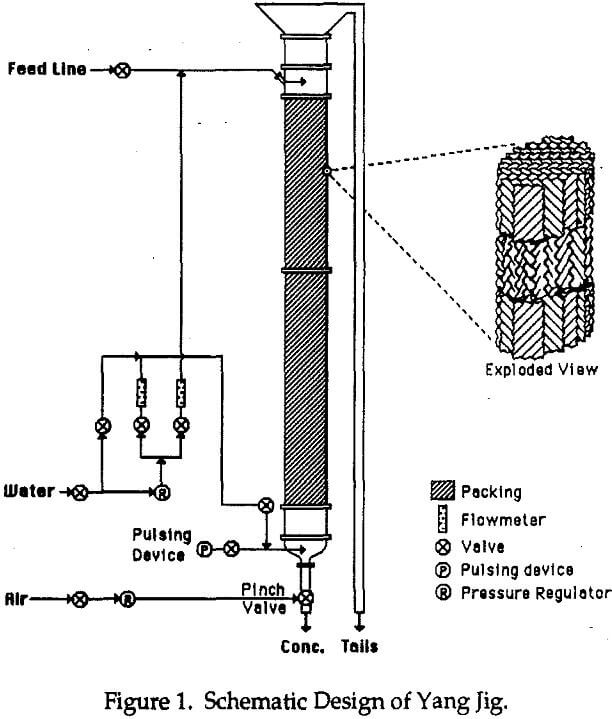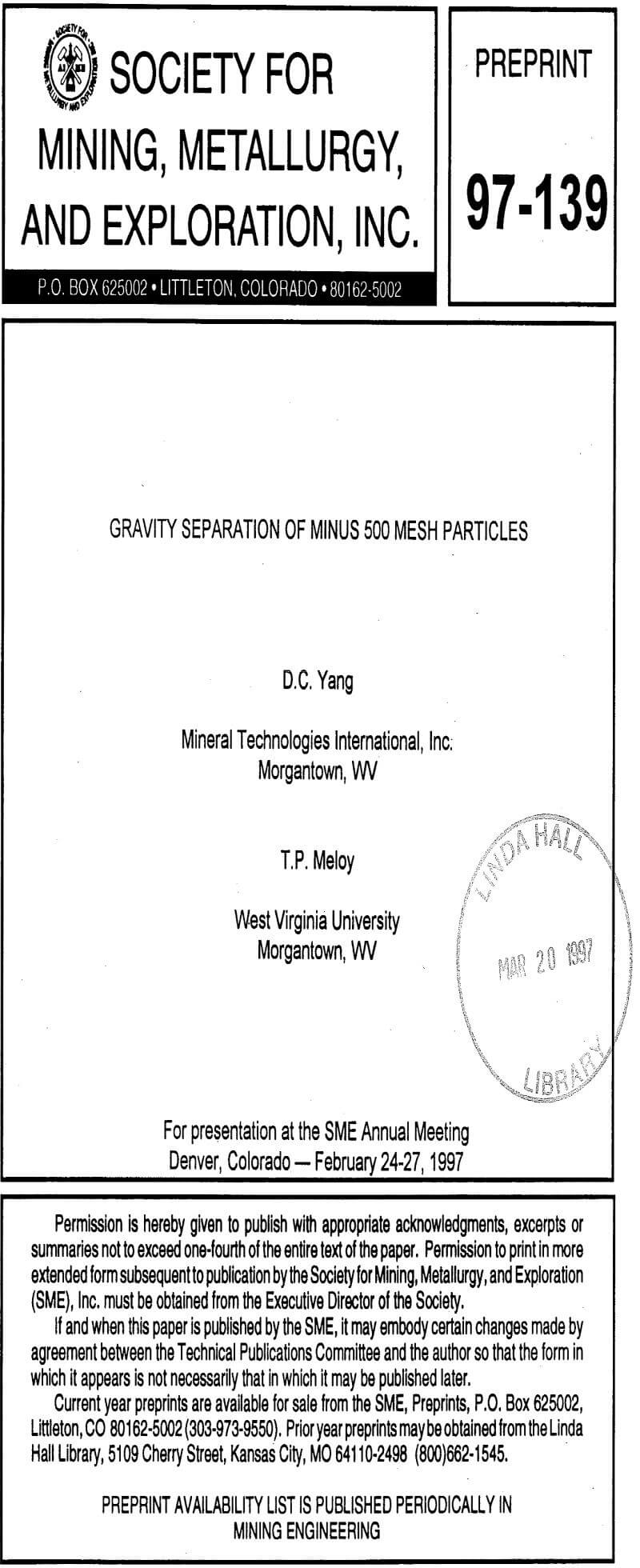The packed jig is a column filled with corrugated diagonal packing. A slurry of mixed particles, the ore, is fed into the middle of the column. Water enters the column near the bottom as both a steady state and a pulsating flow. The pulsating water sets up a jigging action that interacts with the packing causing the dense particles to sink and exit the bottom of the jig while the lighter particles rise and exit the top of the packed jig.
Because of its packing, the packed column jig reduces instabilities and vorticity and thereby decreases short circuiting. As shown in Figure 1, the device consists of a tubular column filled with packing. In the packed jig is an upper low density zone and a lower high density zone. The corrugated packing material extends in a circuitous pattern throughout the column.

The process involves the efficient gravity separation of relatively high and low density particles in a slurry form taking place within the interconnected small jigging cells physically defined by the space between the packing materials. The feed is introduced into the pulp inlet zone for flow through these jigging cells formed by the packing. The separation is achieved by the simultaneous vibrating or jigging of these different bed zones by water pulsation, air pulsation or mechanical vibration. Both the vibration and the reduced cell sizes in a column contribute to effective stratification of different density beds. The low density particles and the high density particles are withdrawn from the two separate discharge outlets-top and bottom.
All separation in the packed jig takes place in the packing. Thus, this tubular packed column gravity separation process does not require flotation, magnetic or cyclone separation. Consequently, the packed jig process is free of flotation agents, magnetic field generating separation equipment and cyclone generators.
The cross-section of the tubular column may be square, rectangular or circular. Fluid flow rate through the column must be sufficient to create a flow in the upper zone which exceeds the terminal velocity of the low density particles. Terminal velocity may be determined via Stokes Law with the variables of particle-size diameter, density, and fluid viscosity. Control may be achieved via feed rate or by utilization of an additional fluid inlet to maintain sufficient linear velocity in the upper zone.
Jigging frequency is the inverse of the particle size. Bed densities may also be controlled to yield a desired grade by point density measurements as well as control of the feed rates and the auxiliary fluids rates-water.
As particle sizes decrease, so does the necessary packing size. Packing is inexpensive, lasts forever, may be damaged and still operates effectively. In fact, the packing may contain holes and the process still works. Because of the motion of particles over the packing surface, one might expect the packing to be abraded. It isn’t. While the packing surface does not remain bright and shiny, the packing surface does remain clean over the years.
While the role of the packing in the separations process is critical, its full role is not yet well understood. Packing permits the development of a multiplicity of boundary layers that play a critical role in the separation process. Moreover, the packing supports the weight- drag of the fluid and interaction of particles with the wall. Because of the alternating diagonal slant of the corrugated packing, the bed properties are homogenized lateral and stabilized vertically.
One critical role of the packing is in the scale-up of the process. Since all separation is done in the packing, scaling up column cross section is linear. Whether one has a two inch diameter column or a twenty foot diameter column, does not matter, as long as the flow rate through a given horizontal area is constant While pilot plant tests are still wise and useful, one can expect a bench size model to behave as will a full-scale column.
Test Procedures
A laboratory packed column (one inch inside diameter by two feet tall) was used in the test work. The column was filled with corrugated packing plates of 1.3 cm (0.5 in.) high with corrugation extending at about 45 degrees of horizontal, and alternate layers or sections were oriented at 90 degrees to each other. In a typical operation, an iron ore, such as magnetic taconite or partially oxidized taconite, is comminuted into a particle size suitable for liberation of the mineral values.
A feed pulp consisting of fine particles, such as 150 mesh top size, is introduced into the column through the pulp inlet at a proper flow rate. The upper section forms a low density bed zone in which silica rich particles are present. The lower section forms a high density bed zone in which iron rich particles are present. The concentrate product stream exits the bottom. Silica, sulfur and phosphorus impurities can be removed effectively from the concentrate with high iron recovery.

